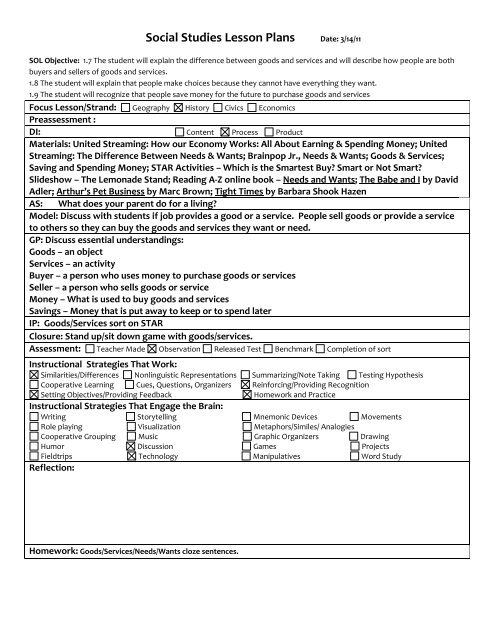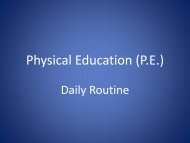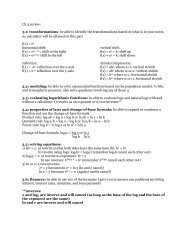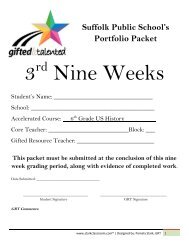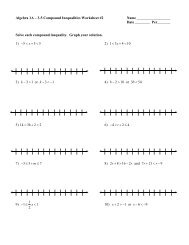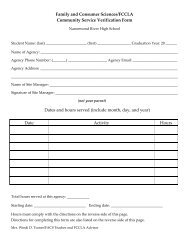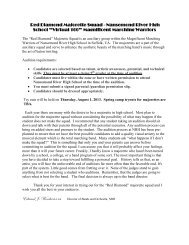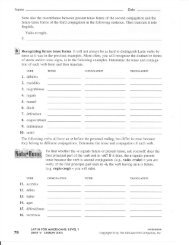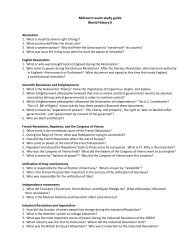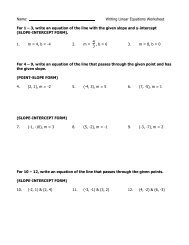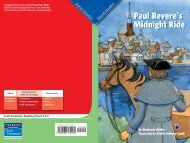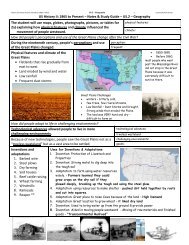Social Studies Lesson Plans
Social Studies Lesson Plans
Social Studies Lesson Plans
- No tags were found...
Create successful ePaper yourself
Turn your PDF publications into a flip-book with our unique Google optimized e-Paper software.
<strong>Social</strong> <strong>Studies</strong> <strong>Lesson</strong> <strong>Plans</strong> Date: 3/15/11SOL Objective: 1.7 The student will explain the difference between goods and services and will describe how people are bothbuyers and sellers of goods and services.1.8 The student will explain that people make choices because they cannot have everything they want.1.9 The student will recognize that people save money for the future to purchase goods and servicesFocus <strong>Lesson</strong>/Strand: Geography History Civics EconomicsPreassessment :DI: Content Process ProductMaterials: United Streaming: How our Economy Works: All About Earning & Spending Money; UnitedStreaming: The Difference Between Needs & Wants; Brainpop Jr., Needs & Wants; Goods & Services;Saving and Spending Money; STAR Activities – Which is the Smartest Buy? Smart or Not Smart?Slideshow – The Lemonade Stand; Reading A-Z online book – Needs and Wants; The Babe and I by DavidAdler; Arthur’s Pet Business by Marc Brown; Tight Times by Barbara Shook HazenAS: Reading a-z Needs and WantsModel: Discuss essential understandings:Goods – things people make or use to satisfy needs and wantsServices – activities that satisfy people’s needs and wantsBuyer – a person who uses money to purchase goods or servicesSeller – a person who sells goods or serviceMoney – What is used to buy goods and servicesSavings – Money that is put away to keep or to spend laterGP: Brainstorm a list of jobs A-Z with students (google “occupations a-z for complete list)IP: students choose letter of alphabet and illustrate a service job that begins with their letter. If timepermits students can write a sentence describing their service job.Closure: Share student writings and drawings. Compile student work into a class book.Assessment: Teacher Made Observation Released Test Benchmark Completion of class bookInstructional Strategies That Work:Similarities/Differences Nonlinguistic Representations Summarizing/Note Taking Testing HypothesisCooperative Learning Cues, Questions, Organizers Reinforcing/Providing RecognitionSetting Objectives/Providing FeedbackHomework and PracticeInstructional Strategies That Engage the Brain:Writing Storytelling Mnemonic Devices MovementsRole playing Visualization Metaphors/Similes/ AnalogiesCooperative Grouping Music Graphic Organizers DrawingHumor Discussion Games ProjectsFieldtrips Technology Manipulatives Word StudyReflection:Homework: Goods/Services/Needs/Wants cloze sentences.
<strong>Social</strong> <strong>Studies</strong> <strong>Lesson</strong> <strong>Plans</strong> Date: 3/16SOL Objective 1.7 The student will explain the difference between goods and services and will describe how people are bothbuyers and sellers of goods and services.1.8 The student will explain that people make choices because they cannot have everything they want.1.9 The student will recognize that people save money for the future to purchase goods and servicesFocus <strong>Lesson</strong>/Strand: Geography History Civics EconomicsPreassessment :DI: Content Process ProductMaterials: United Streaming: United Streaming: How our Economy Works: All About Earning & SpendingMoney; United Streaming: The Difference Between Needs & Wants; Brainpop Jr., Needs & Wants; Goods& Services; Saving and Spending Money; STAR Activities – Which is the Smartest Buy? Smart or NotSmart? Slideshow – The Lemonade Stand; Reading A-Z online book – Needs and Wants; The Babe and I byDavid Adler; Arthur’s Pet Business by Marc Brown; Tight Times by Barbara Shook HazenAS: What is a good? What is a service?Model: Brainpop Jr. video – Goods and ServicesGP: Discuss essential understandings:Goods – things people make or use to satisfy needs and wantsServices – activities that satisfy people’s needs and wantsBuyer – a person who uses money to purchase goods or servicesSeller – a person who sells goods or serviceMoney – What is used to buy goods and servicesSavings – Money that is put away to keep or to spend laterBrainstorm list of goods for each letter of the alphabet.IP: students choose letter of alphabet and illustrate a good that begins with their letter. Students write asentence about their illustrated good (Sha’niyah bought a backpack for school.)Closure: Share student drawings and writings. Compile writings into class book.Assessment: Teacher Made Observation Released Test Benchmark Completion of class book.Instructional Strategies That Work:Similarities/Differences Nonlinguistic Representations Summarizing/Note Taking Testing HypothesisCooperative Learning Cues, Questions, Organizers Reinforcing/Providing RecognitionSetting Objectives/Providing FeedbackHomework and PracticeInstructional Strategies That Engage the Brain:Writing Storytelling Mnemonic Devices MovementsRole playing Visualization Metaphors/Similes/ AnalogiesCooperative Grouping Music Graphic Organizers DrawingHumor Discussion Games ProjectsFieldtrips Technology Manipulatives Word StudyReflection:Homework: Goods/Services/Needs/Wants cloze sentences.
<strong>Social</strong> <strong>Studies</strong> <strong>Lesson</strong> <strong>Plans</strong> Date: 3/17/11SOL Objective 1.12 Origins, customs & traditions (St. Patrick’s Day)Focus <strong>Lesson</strong>/Strand: Geography History Civics EconomicsPreassessment :DI: Content Process ProductMaterials: United Streaming: Holiday Facts & Fun – St. Patrick’s Day (16.13), Scholastic NewsAS: What is St. Patrick’s DayModel: United Streaming VideoGP: Discuss St. Patrick’s Day traditionsIP: Tom and the Leprechaun – Scholastic NewsClosure: Reader’s Theater/You can read for details comprehension answersAssessment: Teacher Made Observation Released Test Benchmark Completion of class book.Instructional Strategies That Work:Similarities/Differences Nonlinguistic Representations Summarizing/Note Taking Testing HypothesisCooperative Learning Cues, Questions, Organizers Reinforcing/Providing RecognitionSetting Objectives/Providing FeedbackHomework and PracticeInstructional Strategies That Engage the Brain:Writing Storytelling Mnemonic Devices MovementsRole playing Visualization Metaphors/Similes/ AnalogiesCooperative Grouping Music Graphic Organizers DrawingHumor Discussion Games ProjectsFieldtrips Technology Manipulatives Word StudyReflection:Homework: Goods/Services/Needs/Wants cloze sentences.
<strong>Social</strong> <strong>Studies</strong> <strong>Lesson</strong> <strong>Plans</strong> Date: 3/18SOL Objective 1.7 The student will explain the difference between goods and services and will describe how people are bothbuyers and sellers of goods and services.1.8 The student will explain that people make choices because they cannot have everything they want.1.9 The student will recognize that people save money for the future to purchase goods and servicesFocus <strong>Lesson</strong>/Strand: Geography History Civics EconomicsPreassessment :DI: Content Process ProductMaterials: United Streaming: United Streaming: How our Economy Works: All About Earning & SpendingMoney; United Streaming: The Difference Between Needs & Wants; Brainpop Jr., Needs & Wants; Goods& Services; Saving and Spending Money; STAR Activities – Which is the Smartest Buy? Smart or NotSmart? Slideshow – The Lemonade Stand; Reading A-Z online book – Needs and Wants; The Babe and I byDavid Adler; Arthur’s Pet Business by Marc Brown; Tight Times by Barbara Shook HazenAS: The Babe and I by David AdlerModel: United Streaming: The Difference Between Needs & WantsGP: Discuss essential understandings:Goods – things people make or use to satisfy needs and wantsServices – activities that satisfy people’s needs and wantsBuyer – a person who uses money to purchase goods or servicesSeller – a person who sells goods or serviceMoney – What is used to buy goods and servicesSavings – Money that is put away to keep or to spend laterBrainstorm list of goods for each letter of the alphabet.IP: Castle of Needs and WantsClosure: Share student castles.Assessment: Teacher Made Observation Released Test Benchmark Completion of class book.Instructional Strategies That Work:Similarities/Differences Nonlinguistic Representations Summarizing/Note Taking Testing HypothesisCooperative Learning Cues, Questions, Organizers Reinforcing/Providing RecognitionSetting Objectives/Providing FeedbackHomework and PracticeInstructional Strategies That Engage the Brain:Writing Storytelling Mnemonic Devices MovementsRole playing Visualization Metaphors/Similes/ AnalogiesCooperative Grouping Music Graphic Organizers DrawingHumor Discussion Games ProjectsFieldtrips Technology Manipulatives Word StudyReflection:Homework: Goods/Services/Needs/Wants cloze sentences.


